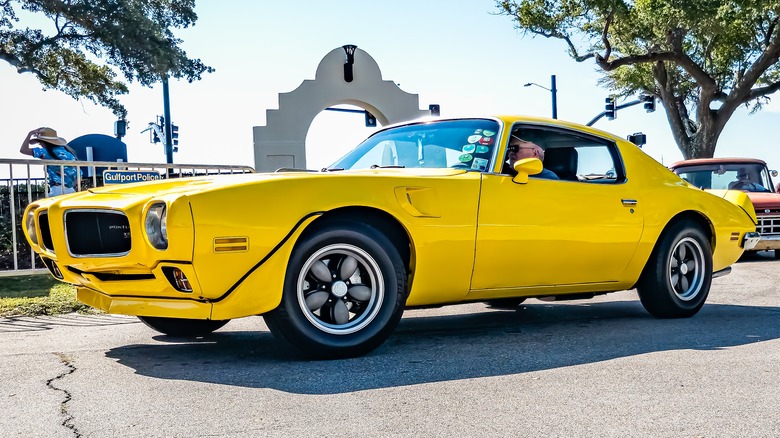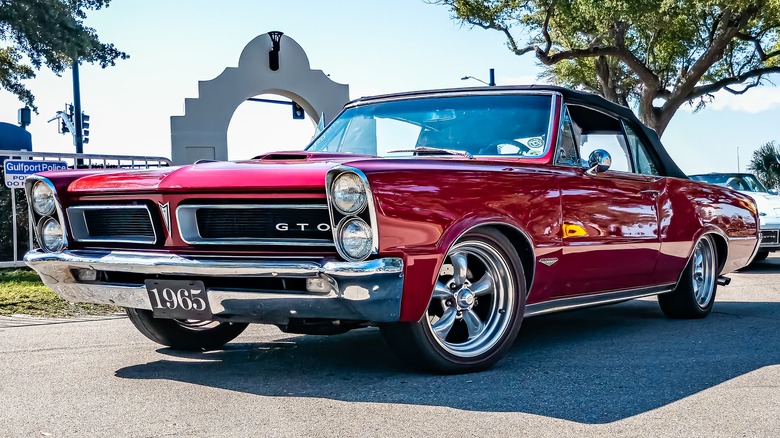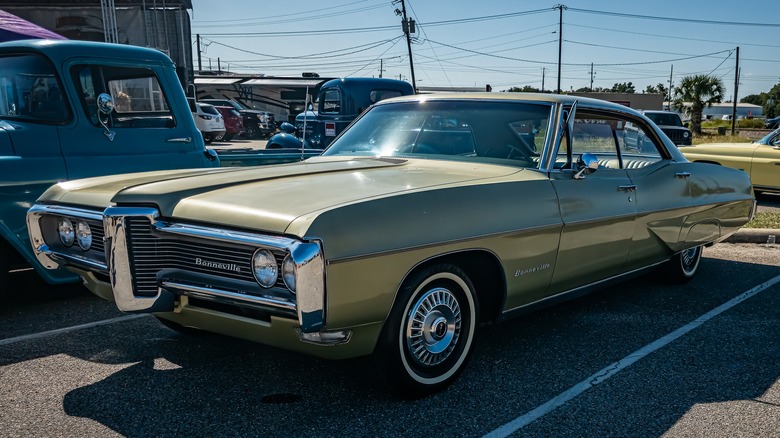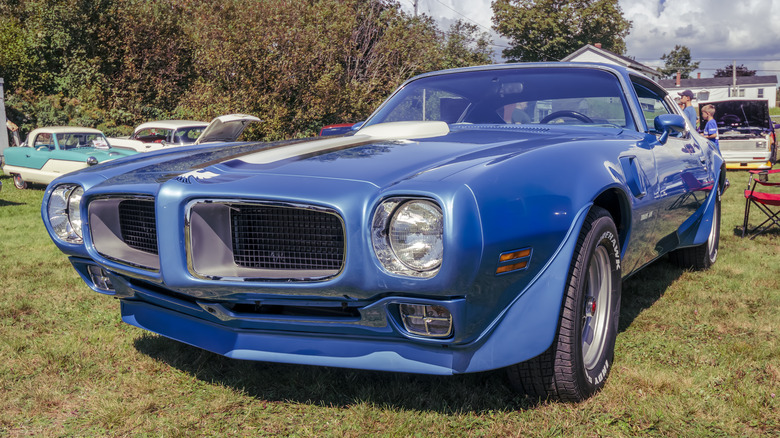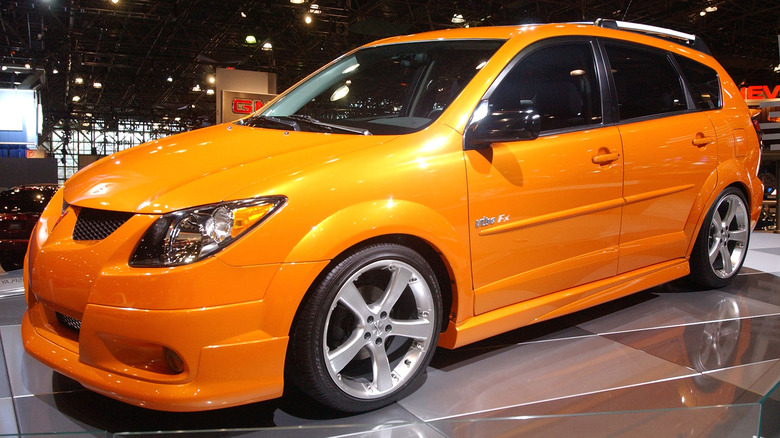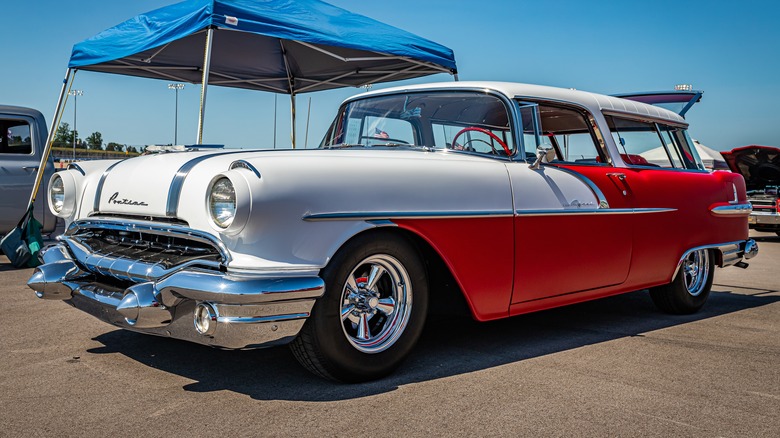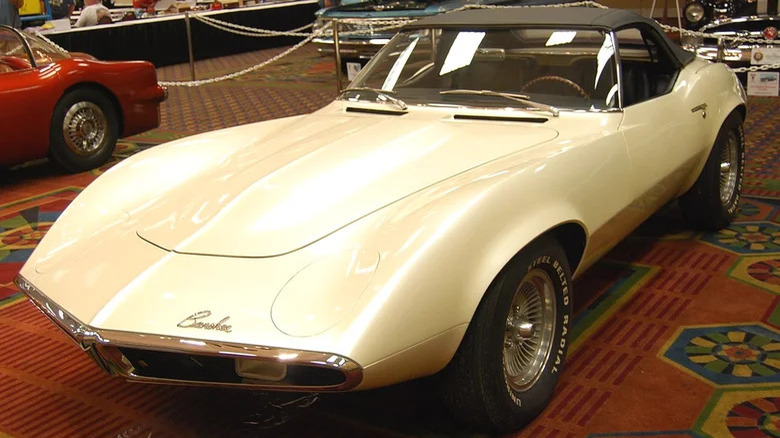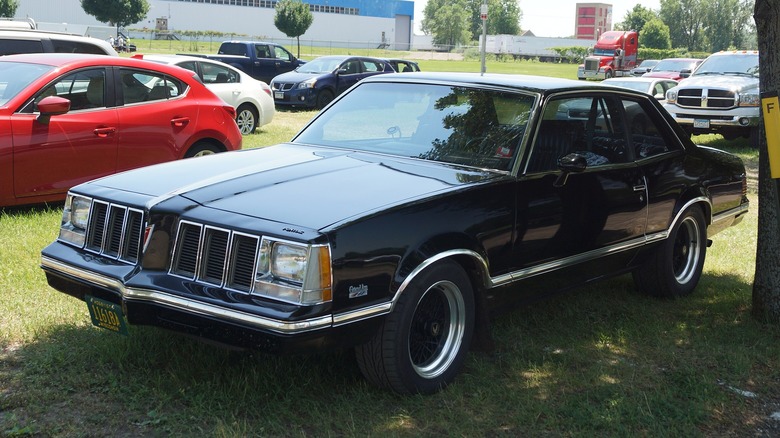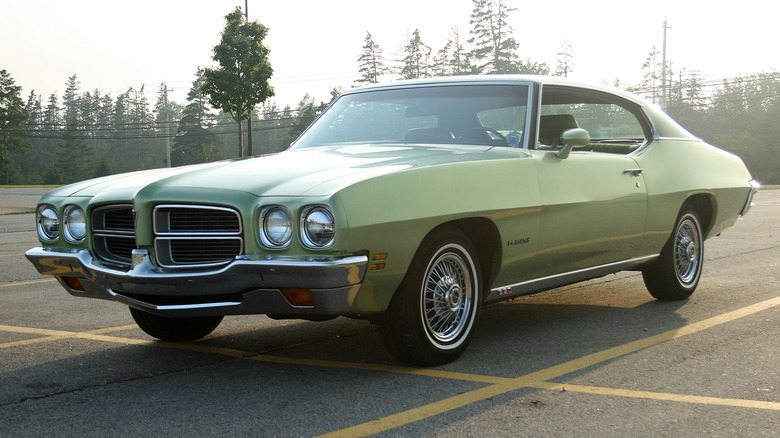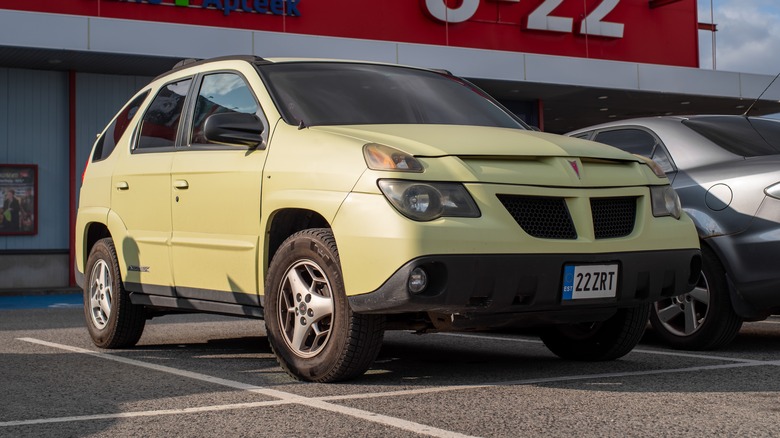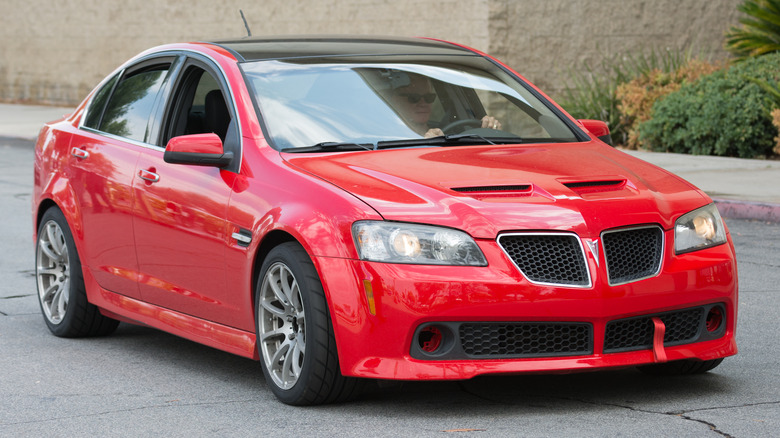10 Classic Pontiac Models That Deserve A Modern Refresh
After a long and storied history spanning more than 80 years of manufacturing, the last Pontiac rolled off the production line in 2010. In an interview with Motor1, former GM executive Bob Lutz called its demise "borderline a tragedy," noting that it had "all the signs of brand health" but was axed as it had been unprofitable for too many years. Despite inevitable rumors to the contrary, GM has never officially stated any intention to bring back the Pontiac brand. Yet, it retains a significant fanbase and a slew of classic models that have remained collector favorites over the years.
If GM were to someday change its mind and bring back the Pontiac brand, there are a wealth of nameplates it could revive to stoke interest in its new lineup. Given the significant changes in the automotive industry in the decade and a half since Pontiac was axed, these nameplates might well end up on cars that are significantly different to their predecessors.
The majority of Pontiac's classic nameplates are theoretically ripe for resurrection, but the below could arguably be a particuarly good fit for a revived Pontiac lineup in today's market.
Pontiac GTO
As one of Pontiac's most famous nameplates, the GTO seems like a natural starting point for a Pontiac revival. Enthusiast interest in the car has remained high in the years since it was discontinued, with the rarest GTO variants fetching hundreds of thousands of dollars at auction and less rare variants boasting an equally strong fanbase. Pontiac already revived the GTO name once in 2004, a few years before the demise of the brand. That car never proved a smash hit thanks to its Aussie roots, as it was little more than a rebadged Holden Monaro.
A new GTO would have to ensure it could wear its American heritage much more authentically, but if it did, it seems like a foolproof way to draw interest to a resurrected Pontiac. A modern GTO powertrain might not appeal to purists, since GM is already phasing out its high-performance gas engines in favor of hybrids and EVs, but it would certainly draw plenty of headlines either way.
Pontiac Bonneville
Another long-running Pontiac nameplate with plenty of cachet among enthusiasts is the Bonneville, which saw several drastic evolutions across its 10 generations. Family sedan sales have been on the decline in America for a while now as buyers switch to crossovers and SUVs, but there's arguably still room in the market for a carefully positioned large sedan. The Bonneville has a history of sportier trims, too — although many are relatively overlooked on the collector market — and so there's already precedent for the brand to launch a variety of standard and peformance powertrain options.
Styling would be one key area that any revived Bonneville would have to get just right, especially since the nameplate has a mixed history in that regard. While the first two generations of the car retain timeless good looks and a keen collector market, it's safe to say that few buyers today are pining for a seventh- or eighth-generation Bonneville.
The sedan market is undoubtedly no longer as lucrative as it once was, and other domestic manufacturers have mostly exited the segment altogether. That means there's arguably a gap in the market for a new American-built, American-badged sedan, and the Bonneville could fill that gap.
Pontiac Firebird
A modern Pontiac revival wouldn't be complete without a new generation of the Firebird, which originally ran from 1967 through to 2002. Various limited-run tributes and restomods have been unveiled in the years since it was axed, which, if nothing else, prove just how well the classic Firebird styling can be adapted to a modern car. The Firebird and closely related Trans Am nameplate are renowned among enthusiasts, although some model years are more fondly remembered than others.
The Firebird was originally conceived as the Pontiac-branded sibling of the Chevrolet Camaro, and there's no reason why a revived Firebird couldn't follow the same formula. There's just one sticking point: as of this writing, there is no Camaro on which to base the Pontiac, since Chevy recently discontinued the model. However, a new Camaro is reportedly in the works and will debut in the coming years. According to a report by MotorTrend, the new Camaro might end up as a four-door or even a crossover, but if it doesn't, it could be a great base for a new Firebird.
Pontiac Vibe
There's no getting away from the fact that any successful brand in today's market needs multiple crossovers and SUVs in its lineup. While a Pontiac revival would almost inevitably see some former passenger car nameplates resurrected as crossovers, the brand does have some existing crossover nameplates in its back catalog. The Vibe was discontinued in 2009 after GM announced its bankruptcy, and by that point it had only been in production for seven years.
It didn't sell well at the time, but given the high market demand for affordable crossovers today, its chances of success this time around seem significantly higher. It was originally built through NUMMI, a joint GM venture with Toyota, although the American automaker wouldn't necessarily need such an arrangement today. GM already makes several Chevy crossovers in-house and could easily repurpose one with some fresh styling and mechanical tweaks. As a result, creating a new Vibe would take only minimal development costs, but would give Pontiac access to one of the most in-demand segments of the modern market.
Pontiac Safari
The Safari name has been used on various wagon variants of Pontiac's cars, with the earliest being the Safari Wagon of the mid-'50s. Wagons have slowly but surely disappeared from the American market as crossovers and SUVs have taken hold, with only Subaru and a handful of European manufacturers continuing to offer them.
If it was revived as an affordable wagon, it at least wouldn't have much competition from within its own segment. The Subaru Outback is the only truly affordable station wagon left after the Mini Clubman was discontinued, and the latter was too small to be a proper family hauler anyway. Wagon offerings from Volvo, Audi, Porsche, and Mercedes-Benz all sit firmly in the premium or luxury categories, leaving a gap at the cheaper end of the market that could theoretically be filled by the Safari. However, sales figures for such a wagon would likely remain small even if it could find its niche. As a result, it seems likelier that a revived Safari would instead take the form of a family hauling SUV or crossover to appeal to a wider audience.
Pontiac Banshee
Banshee was the name given to a series of Pontiac concept cars including the 1964 XP-833, a Corvette-rivaling prototype that was developed at the request of John DeLorean. It was deemed too similar to the Corvette to be built, with GM bosses reportedly worried that the Banshee would eat into Corvette sales rather than take sales away from its competitors. They were still impressed by the car's design, though, to the point where it was used as inspiration for the C3 Corvette that debuted a few years later.
The Banshee name was later reused for several halo car concepts, none of which got anywhere close to production. While the same corporate hurdles would have to be jumped over today thanks to the Corvette's continued success, finally putting a Banshee into production would be a surefire way to attract attention to a revived version of the brand. To avoid cutting into Corvette sales, GM could limit Banshee production to a set amount per year, or diversify its design away from the current mid-engine Corvette.
In reality, such a move is unlikely to happen even if Pontiac was revived. GM bosses would most likely be reluctant to divert funding to a project with such limited returns, although there's a chance that a new Banshee concept could be developed as a marketing tool for the brand.
[Featured image by artistmac via Wikimedia Commons | Cropped and scaled | CC BY 2.0]
Pontiac Grand Am
The Grand Am went through a huge amount of change over its five generations on sale, which makes it a good candidate for resurrection. Its evolution from a rear-drive two-door into a front-drive four door means that Pontiac buyers don't have as much of a fixed image of a Grand Am as they do for a GTO or Firebird. That means fewer are likely to object if the Grand Am became a sporty crossover, which let's face it, Pontiac will need in its lineup if it wants to compete against both its domestic and foreign rivals.
While the fifth-generation Grand Am expanded in size, taking the car back to its compact roots would give Pontiac an entry-level crossover with a familiar name. Much like in previous generations, various trims emphasizing either the car's sporty or luxury attributes could be offered. While there will always be a minority of enthusiasts unhappy about any classic nameplates ending up on crossovers, the Grand Am's history of reinvention arguably makes it a better choice than many other Pontiac names to receive the crossover treatment.
[Featured image by Greg Gjerdingen via Wikimedia Commons | Cropped and scaled | CC BY 2.0]
Pontiac LeMans
Alongside the Grand Am, another widely used Pontiac nameplate is the LeMans, which was used from 1962 through 1981. Various smaller cars wore the name over those two decades, giving a revived Pontiac some creative freedom to reinterpret what the model could look like. LeMans convertibles are among the most desirable on the classic collectors' market, although it seems improbable that Pontiac could return with a convertible model.
After all, even current manufacturers are struggling to sell convertibles in large enough volumes to justify their continued development. A revived LeMans would therefore have to take a different form, and given the current market trends, one outcome seems more likely than the rest. Pontiac could take a leaf out of Ford's book and resurrect its former coupe as a sporty crossover, much like the Capri. Whether it would be a hit is another question, but Ford certainly seems to think the formula will work.
[Featured image by Crwpitman via Wikimedia Commons | Cropped and scaled | CC BY 2.0]
Pontiac Aztek
Depending on who you ask, the Pontiac Aztek was either an ugly mess of a car or it was simply ahead of its time. Perhaps it was both. Certainly the market for strange-looking crossovers has ballooned since the Aztek first arrived, and partly thanks to its cameo in "Breaking Bad," the car has remained in the public consciousness in the years since its unveiling. Those two things combined arguably make it a good candidate for revival, as controversial as the original was.
The Aztek appeals to a younger generation than many of the classic nameplates from Pontiac's muscle heyday, and its polarizing looks and quirky features have meant that it retains a cult fanbase. Clean examples of the car still sell for more than many people would expect, especially those with features like the cooler and tent.
There would of course be some caveats. A new Aztek would need to find its place among the increasingly ugly SUVs of today, while still looking distinctive enough to retain its oddball charm. It would also need to be available with a suitably long list of optional features — tent included — and be marketed at a price where the younger buyers interested in preserving the original Aztek could actually afford to buy a new one. With those things right, there's an argument to be made that Pontiac's most memorable crossover really was just ahead of its time, and therefore deserves to be brought back for a second shot.
Pontiac G8
If a new performance Pontiac two-door was unveiled with the GTO badge, then a four-door counterpart could be marketed under the G8 badge. Similar to the relationship between the recently axed Dodge Challenger and Charger, the G8 could be relaunched as a more practical, family-friendly GTO that kept its muscle looks and performance chops.
The original G8 was a short-lived car unveiled at the worst possible time. The biggest economic downturn in decades was just hitting the U.S. and GM was already on a one-way path towards bankruptcy. After launching for the 2008 model year, the G8 barely got a chance to make an impact with buyers before GM went bankrupt in 2009, sealing the fate of the Pontiac brand.
SlashGear has previously argued that the G8 is a future classic thanks to its rarity and powerful LS V8 engine, with the top-spec G8 GXP being particularly enthusiast friendly. It's unlikely that Pontiac will be revived at all and even more unlikely that it would relaunch with a performance four-door sedan, but if it did, the G8 would be a fitting name for such a car.
